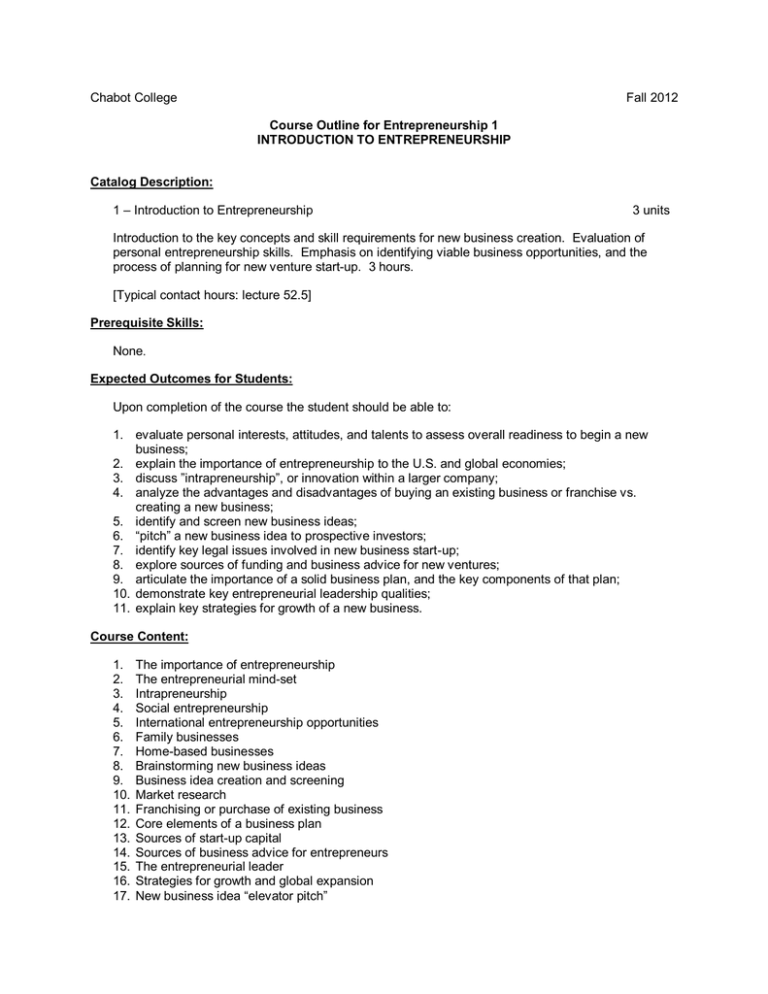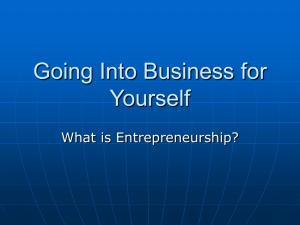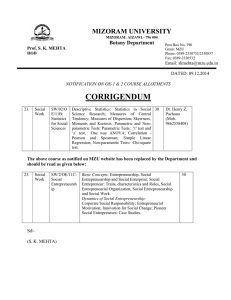Chabot College Fall 2012 – Introduction to Entrepreneurship
advertisement

Chabot College Fall 2012 Course Outline for Entrepreneurship 1 INTRODUCTION TO ENTREPRENEURSHIP Catalog Description: 1 – Introduction to Entrepreneurship 3 units Introduction to the key concepts and skill requirements for new business creation. Evaluation of personal entrepreneurship skills. Emphasis on identifying viable business opportunities, and the process of planning for new venture start-up. 3 hours. [Typical contact hours: lecture 52.5] Prerequisite Skills: None. Expected Outcomes for Students: Upon completion of the course the student should be able to: 1. evaluate personal interests, attitudes, and talents to assess overall readiness to begin a new business; 2. explain the importance of entrepreneurship to the U.S. and global economies; 3. discuss ”intrapreneurship”, or innovation within a larger company; 4. analyze the advantages and disadvantages of buying an existing business or franchise vs. creating a new business; 5. identify and screen new business ideas; 6. “pitch” a new business idea to prospective investors; 7. identify key legal issues involved in new business start-up; 8. explore sources of funding and business advice for new ventures; 9. articulate the importance of a solid business plan, and the key components of that plan; 10. demonstrate key entrepreneurial leadership qualities; 11. explain key strategies for growth of a new business. Course Content: 1. 2. 3. 4. 5. 6. 7. 8. 9. 10. 11. 12. 13. 14. 15. 16. 17. The importance of entrepreneurship The entrepreneurial mind-set Intrapreneurship Social entrepreneurship International entrepreneurship opportunities Family businesses Home-based businesses Brainstorming new business ideas Business idea creation and screening Market research Franchising or purchase of existing business Core elements of a business plan Sources of start-up capital Sources of business advice for entrepreneurs The entrepreneurial leader Strategies for growth and global expansion New business idea “elevator pitch” Chabot College Course Outline for Entrepreneurship 1, Page 2 Fall 2012 Methods of Presentation: 1. 2. 3. 4. 5. Lecture Discussion Video Guest speakers Case analysis Assignments and Methods of Evaluating Student Progress: 1. Typical Assignments a. Interview a local entrepreneur that has been in business for less than 5 years. In a 2-page paper, describe how this entrepreneur developed his/her business idea, the key challenges faced in business start-up, and his/her advice for potential entrepreneurs. b. In an industry of interest to you, locate one established business for sale and one franchise opportunity. In a 5-minute presentation to the class, discuss the start-up costs for each business, and their relative risks and opportunities. 2. Methods of Evaluating Student Progress a. Midterm examination b. Final examination c. Case studies d. Presentations e. Group projects Textbook(s) (Typical): Innovator’s Solution, Clayton Christensen and Michael Raynor, Harvard Business School Publishing, 2003. nd Entrepreneurship, 2 edition or latest, Steve Mariotti and Caroline Glackin, Prentice Hall, 2010. New Venture Creation, 8th edition or latest, Jeffry Timmons and Stephen Spinelli, McGraw-Hill Irwin, 2009. Special Student Materials: None. JVN, ENTR1courseoutline.doc 08.01.11






